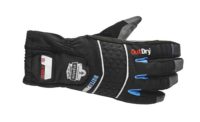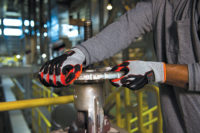How to identify a true winter work glove

Here's how to spot winter hand protection that works – and why it matters. First, let’s address the dangers of cold stress:
Frostbite: The freezing of skin tissue can have painful consequences, and the effects can linger for life. It's not just sub-zero air temps and wind chills workers need to protect themselves against. Handling metal tools and machinery leaves hands more susceptible to frostbite.
Increased accidents: Frigid fingers start losing their grip on any number of tasks, from maintaining a grasp on a ladder to holding on to objects that can cause damage to people and property if dropped.
Reduced productivity: Time spent trying to keep hands warm is time spent not being productive. Same goes for time spent recovering dropped objects. Or stopping work to assess the damage done by or to those dropped objects.
Think thermal first
The best winter work gloves are built from the ground up for protection from the elements first, enhanced with specific features that consider the needs of the worker. Two of the biggest faults of gloves simply retrofitted for winter protection are found in the fit and materials. Cramming insulation into an existing design might have a negative effect on how a glove fits. And an improper fit reduces the level of protection.
And materials that might do the job wonderfully in July become part of the problem in January. Traditional spandex, for example, is used in work gloves because of its lightweight, flexible, resilient, and breathable properties. In the winter, that same material also happens to absorb water and let cold air in. Other work glove materials – PVC palm reinforcements for example – stiffen and freeze up when the temps dip, making it hard to maintain dexterity.
Anatomy of a true winter work glove
So what exactly should we be looking for in a "true" winter work glove?
Outer shell: Consider it your first line of defense. Ripstop nylon with a DWR (Durable Water Repellent) finish not only fends of the wind and the wet stuff, it will stay pliable in plummeting temps.
Insulation: To maintain warmth and dexterity, look for gloves with dual-zone insulation that use a heavier, higher-loft insulation on the back of the hand, and thinner, lower-weight insulation on the palm.
Waterproofing: In addition to a water repellent finish on the outer shell, serious winter work gloves are built with a waterproof membrane to bolster protection. This additional layer shuts out moisture from the outside while allowing sweat to escape. The most effective design is the one that bonds the membrane to the outer shell. This eliminates the "gap" that is created between standard membrane inserts and a glove's outer shell, which can collect water and cold air.
Fit: Gloves that are too big will hinder dexterity; gloves sized too small will constrict movement and stifle air flow. Especially important for winter work gloves is a cuff and closure to keep in warmth and lock out cold, such as an extended neoprene cuff with hook-and-loop closure or a gauntlet cuff with an internal elastic cord.
Tech-Friendly: Look for thermal gloves that employ a touch screen option to allow for swiping and answering calls on mobile devices without the need to remove the glove.
Looking for a reprint of this article?
From high-res PDFs to custom plaques, order your copy today!





